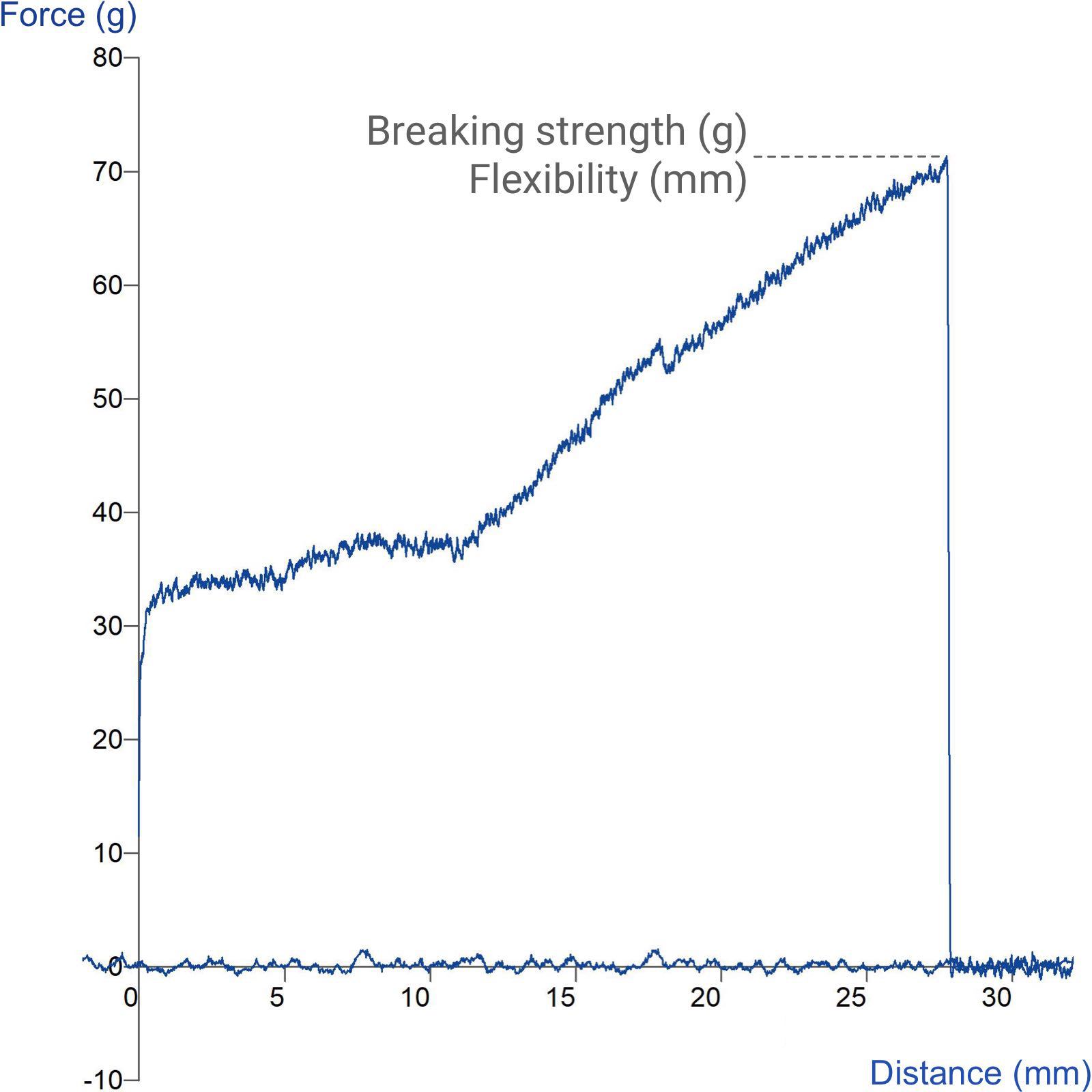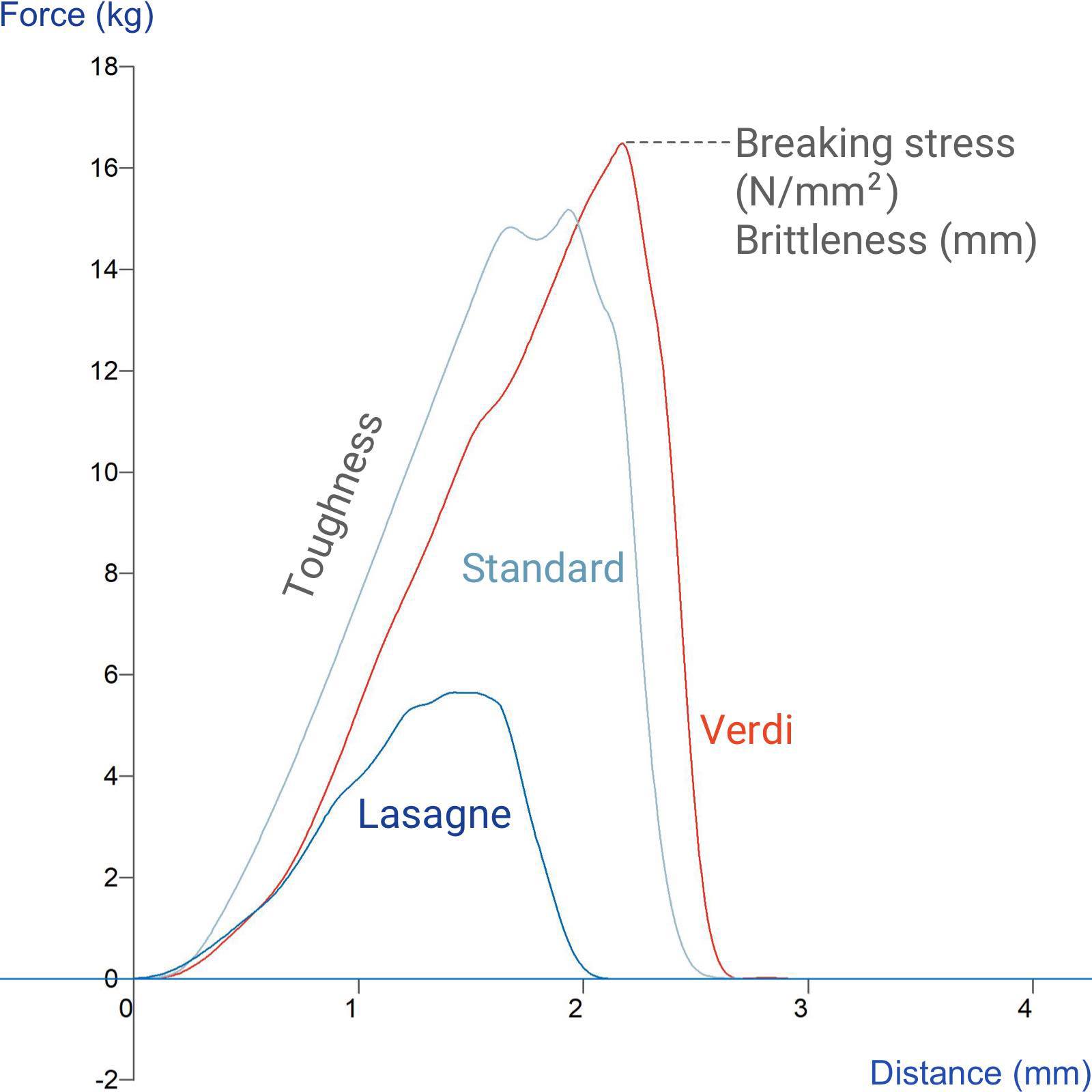How to measure flexibility / bending force

Bending force: definition and importance
Flexibility and bending force are important properties that describe how a material responds to bending or flexing. The higher the force required to bend, the firmer or stiffer the material. Stiffness is associated with materials that resist bending and have high hardness, while flexibility describes materials that can bend, flex, or deform to a greater degree before breaking. Bending tests are useful for determining a material's break strength and flexibility, which are critical in product development and quality control.
Flexibility refers to how much/far a material can bend without breaking, while bending force is the amount of force required to cause the material to bend. These properties are relevant in a wide range of industries, including food, textiles, construction and packaging materials. A flexible material can undergo significant deformation before reaching its breaking point, while a rigid material will resist bending and might break under lower bending forces.
A material with high flexibility will bend over a longer distance and require less force to bend initially. A material with high bending force will resist bending, showing a steep increase in force over a short distance or time before reaching its limit. While flexibility and bending force are related, they're not always inversely proportional:
- High flexibility, low bending force: Easily bends with little force (e.g., thin plastics)
- High flexibility, high bending force: Bends significantly but requires more force (e.g., thick rubber)
- Low flexibility, low bending force: Breaks easily with little bending (e.g., brittle ceramics)
- Low flexibility, high bending force: Resists bending and requires high force to deform (e.g., steel)
By analysing these aspects of flexibility and bending force test graphs, engineers and product developers can objectively quantify and control the mechanical properties of their materials. This data is crucial for designing products that meet specific performance requirements, ensuring durability, and optimising material selection across various applications. Understanding flexibility and bending force helps in predicting material behaviour under stress, improving product designs, and ensuring safety and reliability in diverse industries.
Further example applications of bending force and flexibility testing
Bending force and flexibility testing using a Texture Analyser is valuable across industries, such as materials science, manufacturing, and product development. Below are key applications:
- Plastic material flexibility testing: Evaluating the flexibility of plastics like PVC or polyethylene by measuring the force required to bend pipes or sheets ensuring package integrity under bending stress.
- Food bending force assessment: Crackers and breadsticks generally have low flexibility and high bending force, meaning they break quickly when bent. The graph will show a sharp rise in force followed by a rapid drop, indicating that they snap with little bending. Fresh pasta has high flexibility and bends easily without breaking. The force vs distance graph will show a gradual curve, indicating that the pasta bends over a longer distance before breaking. Dry pasta, on the other hand, is more rigid and will show a steep rise in force, breaking quickly after a short distance of bending.
- Textile fabric/apparel bending force testing: Assessing the bending force needed to deform textile fabrics used in clothing, upholstery or footwear soles and insoles by measuring their flexibility.
- Paper and cardboard flexural rigidity testing: Testing the stiffness of paper and cardboard by applying force to bend them, assessing their flexural rigidity for packaging or printing.
- Electrical cable flexibility testing: Assessing the flexibility of electrical cables by measuring the force needed to bend them to meet installation requirements.
- Polymer film bend force testing: Testing the flexibility of polymer films used in electronics or packaging by measuring the force required to bend the film. Plastics used in flexible packaging or films will show high flexibility, bending over long distances with minimal force. Rigid plastics used for structural components will show higher bending forces and shorter distances to peak force.
- Medical device flexibility evaluation: Evaluating the flexibility of medical devices like catheters, prosthetics, tubing and stents by measuring the force required to bend them for medical applications.
- Wood material bend strength testing: Measuring the bend strength of wood used in construction by applying force to bend boards or beams to assess structural integrity.
- Rubber and elastomer flexibility testing: Testing the flexibility of rubber and elastomeric materials used in seals and automotive components by measuring the force needed to bend them.
- Composite material bend testing: Assessing the flexibility and durability of composite materials used in aerospace or automotive applications by measuring the force needed to bend composite panels.
In these examples, a Texture Analyser applies controlled bending forces/distances to quantify the flexibility and bending resistance of materials. These measurements are critical for quality control, product development, and material characterisation.
Typical probe/attachment used for measurement
In a typical flexibility/bend force measurement test, a three-point bend test or a cantilever test is used. In a three-point bend test, the sample is supported at two points and force is applied at the midpoint. In a cantilever test, one end is fixed while force is applied to the free end.
How to interpret the Texture Analyser graph
When measuring bending force/flexibility, the force vs distance/time graph typically shows an obvious peak with a sharp drop in force representing the amount of force and distance needed cause sample failure. From the graph you can observe/obtain the following:
- Stiffness
- Hardness
- Brittleness
- Breaking strength
- Fracturability
 Typical curve indicating key analysis points of flexure test
Typical curve indicating key analysis points of flexure test
 Typical curve indicating key analysis points of flexible sample bend test
Typical curve indicating key analysis points of flexible sample bend test
A full explanation of these curves and their analysis can be accessed within Exponent Connect software. Existing Exponent users can upgrade to Exponent Connect specification.
Below is a video example of how we can help you understand curve analysis for an example property.
Key factors affecting flexibility/bending force measurement
- Sample dimensions: Width and height significantly impact calculations.
- Environmental conditions (temperature, humidity) can influence flexibility measurements.
- Support gap: The distance between supports (for three-point bending) must be accurately controlled.
- Sample uniformity: Cross-section should be uniform for accurate results. For anisotropic materials, testing in multiple orientations may be necessary.
- Test speed: The rate of bending can impact results, especially for viscoelastic materials.
Collecting additional measurements during your test

Acoustic Envelope Detector
The Acoustic Envelope Detector can by employed for any material which produces an audible noise when tested as it captures another dimension (i.e. sound) during the test which can also be analysed and used as a measured product feature.

Video Capture and Synchronisation System
The Video Capture and Synchronisation System can by employed to record and replay any test but is particularly suited to those tests that occur quickly, contain a fracture event or can easily be missed with the human eye. Data can be shared and viewed by colleagues or used as an educational tool to teach about the features of a product’s breakdown.
Optimising flexibility/bending force measurement and analysis: The Stable Micro Systems advantage
The Stable Micro Systems Texture Analyser excels in optimising flexibility and bending force measurements through its comprehensive approach and specialised features. Equipped with dedicated tools like the Three Point Bend Rig, Lipstick Cantilever Rig and Spaghetti Flexure Rig, it precisely quantifies properties such as stiffness, hardness, brittleness, and breaking strength.
The Texture Analyser’s versatility allows for various tests including bending, flexing, and deformation across a wide range of materials, from food items to industrial products and cosmetics. Exponent Connect software captures detailed force-time-distance profiles at 2000 points per second for in-depth analysis, while customisable test solutions ensure adaptability to unique sample requirements.
Backed by Stable Micro Systems' expertise in method development and data interpretation, makes it the ideal choice for industries seeking to refine product formulations and maintain quality standards in flexibility and bending force testing.
A choice of dedicated attachments to imitate a bending action for precise flexibility testing.
Comprehensive analysis of graph features with multiple flexibility parameters.
Ability to additionally measure video or sound using an Acoustic Envelope Detector for fast occurring fracture events.
Adjust settings to simulate real-world usage conditions capturing data at 2000 points per sec.
If you need help with your bending force measurement, we offer unrivalled support.
We can walk you through the steps to successful testing and analysis of bending forces.











